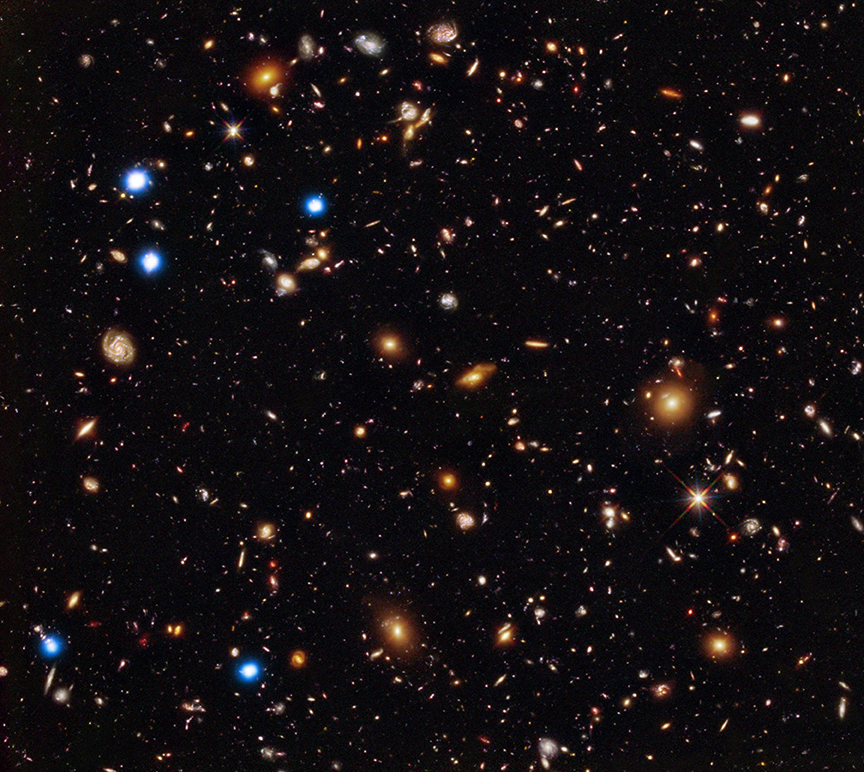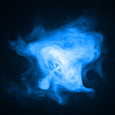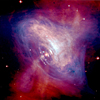Disclaimer: This material is being kept online for historical purposes. Though accurate at the time of publication, it is no longer being updated. The page may contain broken links or outdated information, and parts may not function in current web browsers. Visit chandra.si.edu for current information.
Look Back Time -- Remembering Franco
by Wallace TuckerOct 26, 2012 ::
The finite speed of light means that we must always be out of date, no matter how hard we strive to keep up with the times. The term look-back time refers to the time in the past when the light we now observe from a distant object was emitted. For example, deep Chandra observations have detected X-rays that have been travelling through intergalactic space for billions of years since they were emitted by jets of gas that were likely produced by rotating supermassive black holes. With these data, astronomers use Chandra and other telescopes as one-way time machines that enable them to see objects as they were in the past.
In our personal lives, letters, photographs, and other documents serve as time machines as they stimulate the mystic chords of our memories, and send us traveling back into the past. I recently took an especially poignant trip back to the past when I received the sad news that Franco Pacini had died.
Franco and I first met many years ago as young postdoctoral researchers sharing an office at Cornell University. We soon became friends and would often spend weekends exploring the back-country around Ithaca, and going to auctions at small farms in the area. One of our purchases was an old toboggan, which we tested soon after the first snow, and quickly learned that neither of us knew how to guide it. Fortunately we were saved from serious injury by a snowdrift, but it made a lasting impression on Franco - he referred to it in the last email I received from him. We also shared family dinners. I remember one in particular where Franco demonstrated how to tell that the spaghetti pasta was done by flinging it against the ceiling. If it stuck, it was ready.
During the day, we talked astrophysics, and it was during one of those conversations that Franco showed me a draft of paper he was writing on energy emission from a rotating, highly magnetized neutron star. His argument went roughly as follows. Theoretical models for the evolution of a massive star show that, in the last phases of the star's evolution, the core collapses to form an ultra-dense object called a neutron star.
What happens next is still not well understood, but there is general agreement that the formation of the neutron star releases a tremendous amount of energy which ejects the outer layers at high speeds in a supernova explosion. The neutron star, meanwhile, like a figure skater whose rotation rate increases when she pulls in her arms, should have acquired an extremely rapid rate of rotation when it formed from the collapse of the stellar core. It should also have acquired an enormously strong magnetic field.
Adapting an idea presented in another context as a problem from a classic physics textbook, Franco showed that a highly magnetized, rapidly rotating neutron star could in principle produce a prodigious amount of energy in the form of very low frequency electromagnetic waves. This process could, he speculated, be the long-sought source of energy needed to explain the acceleration of particles to extremely high energies in the Crab Nebula supernova remnant.
My immediate reaction was the one people often have when presented with a simple, elegant idea: Why didn't I think of that??? You have to realize that Franco's paper was published in 1967, when evidence for the existence of neutron stars was still awaiting the discovery of pulsars the next year, and the discovery of the Crab Nebula pulsar was almost a year in the future. Within a couple of years, others had developed the model of the highly magnetized, rapidly rotating, neutron star further, and it became the accepted model for pulsars. This model received dramatic confirmation more than 3 decades later when Chandra made spectacular X-ray images of the region surround the Crab pulsar.
Thanks to Chandra, it is now known that the Crab Nebula is just the most prominent example of a class of objects called "pulsar wind nebulae," in which a rapidly rotating neutron star has created a cloud of high energy particles that extends over several light years. See http://chandra.si.edu/photo/2009/b1509/ and other examples in the Chandra photo album.
Franco realized that the generation of energy by rotating neutron stars could be a special case of a process with much broader application: the transformation of gravitational energy to rotational energy, and the transformation of rotational energy into high-energy particles and radiation. When a object -a star, or a massive gas cloud or star cluster in the center of a galaxy -- collapses, its rotation rate increases, its magnetic field gets stronger, and it becomes a powerful cosmic generator.
In another prescient article in 1973, co-authored with Martin Rees, they wrote that "the source of energy in pulsars, quasars, and other strange objects -may be gravitational energy converted into rotational energy as a large object contracts to a smaller one." This is the generally accepted view today for how accreting black holes can produce such prodigious amounts of energy.
Franco's keen scientific intuition, charming manner, and powers of persuasion were put to effective use, first as director of the scientific division of the European Southern Observatory, and then for two decades as the director of the University of Florence's Arcetri Observatory. As the affectionately termed "King of Arcetri" he transformed Arcetri into one of Europe's leading astrophysical institutes.
He served as President of the International Astronomical Union from 2001 to 2003. In that capacity he launched the idea of the International Year of Astronomy in 2009 to commemorate the 400th anniversary of Galileo's first recorded astronomical observations with a telescope, a celebration in which the Chandra EPO team played a leading, award-winning role. See http://chandra.harvard.edu/press/10_releases/press_022610.html
Franco was also very popular as a science communicator, and was much in demand as a public lecturer, and TV commentator. His greatest attention and efforts were devoted to children since he strongly believed that astronomy is particularly suited for introducing the scientific method, thus educating a rational approach to problems. Several news reports of his death referred to him as the "great children's astronomer." In the long run, this may be the most important legacy of a distinguished career.
Disclaimer: This material is being kept online for historical purposes. Though accurate at the time of publication, it is no longer being updated. The page may contain broken links or outdated information, and parts may not function in current web browsers. Visit chandra.si.edu for current information.








